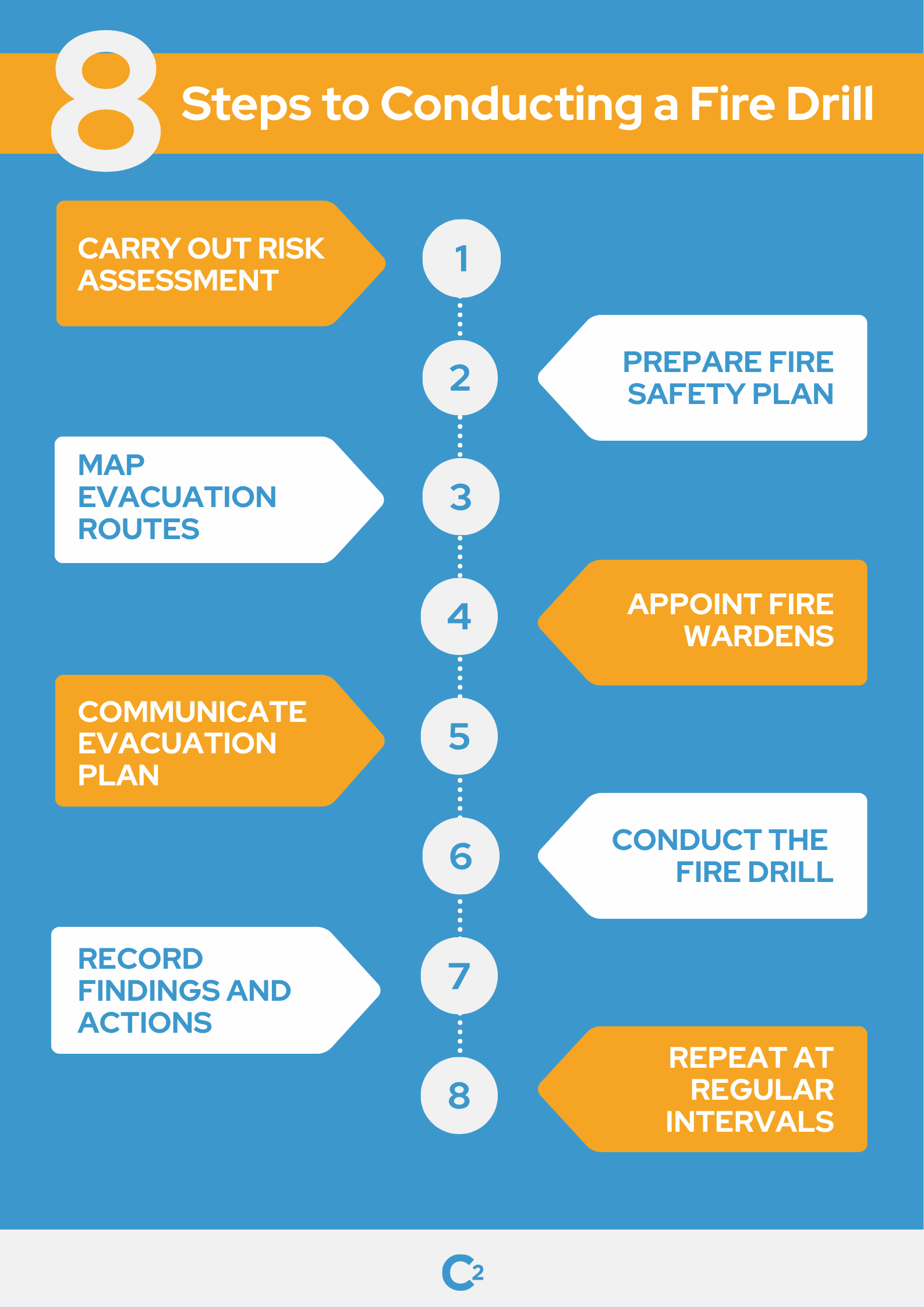What Is a Fire Drill, and How to Conduct a Fire Drill at Work
Published on August 07, 2025
Last updated on August 07, 2025
Jump to a section
A resilient business is one where all staff are prepared for emergencies, no matter how big or small. Fires can be one of the most devastating emergencies a business can face, with risks to resources and equipment, property, and, worst of all, the lives of personnel.
Staff need to know how to behave during these times of crisis. Conducting fire drills will minimise the risk of injury and death, helping you bounce back from real fire emergencies and reduce business downtime. Section 15 of the Regulatory Reform (Fire Safety) Order 2005 (FSO2005) also requires businesses to establish and implement fire drills in preparation for emergency fire situations.
Here is how to do it, with guidance on tools to help you track and log your fire management plan.
Fire Drill Definition
A fire drill is a safety procedure during which building occupants practice how they will respond in the event of a fire. It includes the sounding of alarm systems, an evacuation process, and a post-evacuation roll call at designated assembly points.
Why Are Fire Drills Important?
Fire drills help your business to prepare for the worst, mitigating the harmful effects of what could be a business crisis. They are a multi-purpose tool that tests safety equipment, helps staff become familiar with evacuation procedures, and evaluates communication systems. Let's examine each element.
Smooth evacuation procedures
When fire witnesses have limited knowledge of the situation, they are more likely to panic, according to a study by the Institute of Public Safety Research at Tsinghua University. Regular fire drills help staff become familiar with evacuation routes, understand how to assist colleagues with mobility needs, and know where to assemble outside. Increased emergency awareness from procedure practice means evacuations are more likely to be calm, safe, and efficient.
Operational fire safety equipment
A fire drill is an opportunity to test that all building fire safety equipment is working and in good order. The main equipment tested during a fire drill includes:
- Fire alarm system: Lights and sirens that flash and sound when triggered by heat and/or smoke.
- Fire doors: Fire doors that close automatically in the event of a fire, blocking the spread of heat and smoke.
- Fire exit doors: Situated at fire escapes, fire exit doors are equipped with panic bars for easy operation. They should be free from obstacles and open easily.
- Fire exit signs: Fire exit signs should be clearly visible, well-lit, and positioned correctly above all designated escape routes and exits.
Efficient communication systems
The FSO2005 advises that a fire warden be appointed, along with safety officers, to facilitate smooth evacuation. A fire drill checks that communication channels between parties are clear and that it is easy to access relevant contact information, like phone numbers. Facilitate real-time, organised updates by using an incident management tool to integrate internal communication channels with incident pages and task lists.
Legal and regulatory compliance
Most businesses have a legal obligation to carry out regular fire drills as an integral part of fire safety measures, with Article 32 of the FSO2005 stating that employers who fail to comply may risk fines and/or imprisonment up to two years. Having clear instructions on what your business will do in a fire emergency will help your business adhere to regulations.
Step-By-Step Guide to Conducting a Fire Drill
You must conduct a scheduled drill at least once per year. For initial drills, inform staff in advance to ensure procedures are understood and executed correctly. For subsequent fire drills, you may wish to simulate a real emergency procedure by running unannounced exercises at unexpected times. Use this process to tick all the boxes.

1. Carry out a risk assessment
Before running any fire drill, conduct a risk assessment to identify hazards introduced by the drill itself and plan for any foreseeable issues.
- Ensure that fire exits are unobstructed
- Account for people with mobility, sensory, or language needs
- Confirm alarm systems and emergency lighting are operational
- Identify backup assembly points in the eventuality of adverse weather or site works
2. Prepare a fire safety plan
Develop or update your fire safety plan to cover the full scope of fire safety regulations. It must be easily accessible and include:
- Evacuation procedures
- Named roles and responsibilities
- Alarm activation points and equipment locations
- Communication protocols during and after the drill
3. Map evacuation routes and emergency exits
Ensure that evacuation routes are:
- Supported by up-to-date floor plans
- Clearly marked with light-up fire signage
- Reviewed regularly for changes to the layout
4. Appoint fire wardens and safety officers
Choose an appropriate number of fire wardens and safety officers, based on building size, occupancy, and risk level. Provide training to teach the procedure for:
- Guiding staff and visitors to safety
- Understanding the fire safety plan and building layout
- Checking designated areas and reporting on their status
- Escalating immediately if someone is missing or unaccounted for
- Checking alarms, fire extinguishers, and other key safety systems
5. Communicate the evacuation plan
Communicate the evacuation plan to all relevant parties, ensuring that information is conveyed in an accessible way. Do this by:
- Incorporating fire safety into onboarding and mandatory training
- Reinforcing evacuation protocols regularly via internal communications
- Displaying printed instructions and escape routes throughout the site
6. Conduct the fire drill
Run the drill by activating the alarm system from a manual call point. Observe the evacuation, paying attention to timing, bottlenecks, and any confusion or non-compliance. Once staff are at their assembly points, fire wardens must:
- Conduct roll calls and report missing persons immediately
- Escalate issues using the agreed communication protocol
- Log observations in real time to support post-drill analysis
7. Record findings and actions
Document outcomes and identify areas for improvement to support compliance and drive corrective action. C2's corrective action module allows you to:
- Assign and track follow-up actions
- Log drill results and response times
- Note equipment faults or communication issues
8. Repeat at regular intervals
To avoid predictability and test real-world readiness, vary the timing and context of drills. After each exercise:
- Refine your evacuation procedure based on identified gaps
- Keep records current using automated logs and status reports
- Confirm that all corrective actions have been implemented
How Continuity2 Supports Fire Drill Management
C2's business continuity software is designed with crises in mind. It's your incident plan, recovery guide, and emergency files, all in one place.
With our state-of-the-art management system, you can:
- Schedule fire drills and record attendance
- Track post-drill findings and corrective actions
- Include drills in wider incident and resilience planning
- Use Management Information (MI) to organise essential files
A robust fire drill procedure could be the difference between life and death. Don't take any chances, and ensure every staff member knows what is expected of them during these dangerous disruptions.
Take your preparations to the next level. Book your C2 demo today and overhaul the way you approach fire safety in your organisation.
Written by Lisa McStay
Chief Operating Officer at Continuity2
As a proud COO of Continuity2, Lisa strives to provide intuitive and innovative solutions for the Business Resilience market and reshape the industry as we know it today. Lisa has been in the industry for over 10+ years, helping clients achieve their Business Continuity and Resilience objectives for continuous growth and success.


Written by Lisa McStay
Chief Operating Officer at Continuity2
As a proud COO of Continuity2, Lisa strives to provide intuitive and innovative solutions for the Business Resilience market and reshape the industry as we know it today. Lisa has been in the industry for over 10+ years, helping clients achieve their Business Continuity and Resilience objectives for continuous growth and success.